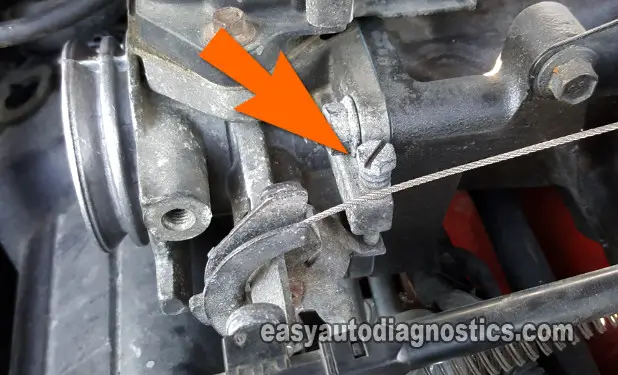TEST 2: Making Sure The TPS Is Getting 5 Volts And Ground

If you've reach this point, then your 3.8L Ford Mustang's throttle position sensor did not pass TEST 1.
So, before we condemn the TP sensor as defective, we need to make sure that it's getting 5 Volts and Ground. We can easily verify these two by doing a simple multimeter test.
The wire that feeds power (5 Volts) to the TP sensor is the brown with white stripe (BRN/WHT) wire. This wire connects to the TP sensor terminal identified with the number 3 in the illustration above.
The wire that feeds Ground to the TP sensor is the grey with red stripe (GRY/RED) wire of the connector. This wire connects to the TP sensor terminal number 1 in the illustration above.
NOTE: A word of caution, the Ground wire is supplied to your Ford's TP sensor by the fuel injection computer (internally by the fuel injection computer). This means that you have to be very careful not to apply 12 Volts to the grey with red stripe wire or you're going to fry the computer. The multimeter voltage test that I'm suggesting (in the instructions below) is a safe way of testing the TP sensor's Ground circuit.
These are the test steps:
- 1
Check the BRN/WHT wire for power with the Key On Engine Off (KOEO) (see illustration above).
Back probe the wire that connects to terminal number 3 with the red multimeter test lead and connect the black lead to the battery negative (-) post.
The multimeter should register 4.5 to 5 Volts DC. - 2
Check the GRY/RED wire for Ground with the Key On Engine Off (KOEO) (see illustration above).
Back probe the wire that connects to terminal number 1 with the black multimeter test lead and connect the red lead to the battery positive (+) post.
The multimeter should register battery voltage (12+ Volts).
Let's interpret your test results:
CASE 1: The TPS is getting 5 Volts and Ground. This is the correct test result.
Taking into account that you've reached this point because the TPS did not pass the test in TEST 1 and that it is getting 5 Volts and Ground, you can now correctly conclude that the TPS on your Ford Ranger is defective. Your next step is to replace the throttle position sensor.
CASE 2: The TPS is not getting 5 Volts or Ground. Without 5 Volts or Ground the throttle position sensor will not work.
The next step is to find out why power or Ground is missing and resolve the issue. I can tell you from personal experience that usually what causes this to happen is an open circuit in the wires between the fuel injection computer and the TPS connector.
TPS Trouble Code Won't Go Away

Several different factors can provoke the computer on your Ford Mustang to think that the TP sensor is malfunctioning. This of course will light up the check engine light and set a TPS diagnostic trouble code.
Since I've seen this happen quite a few times before, here are some suggestions that I think will help you to solve the case.
- Make sure that the TP sensor connector isn't damaged. Specifically, the locking tabs of the connector break and will cause a false compact type of problem.
- Verify that the idle stop screw hasn't been misadjusted (see photo above). Generally , when the idle stop screw has been adjusted, it's done to compensate for a rough idle condition. What you'll see is that the idle-stop screw is turned inwards to rev up the engine at idle. What sucks about this, is that the fuel injection computer thinks at the TP sensor is defective.
- Verify that there's continuity between the TP sensor connector's wires and the fuel injection computer. If any of these wires are open, the fuel injection computer will light up the check engine light.
- Check that the fuel injection computer isn't fried internally. What I've done to be able to diagnose a defective computer is the following:
- First: Eliminate the TP sensor itself as defective.
- Second: Check the continuity of the TP sensor three wires between the TP sensor's connector and the fuel injection computer's connector.
- Third: Make sure that the computer has good Ground. I do this by doing a voltage drop test on the computers Ground wires.
- Fourth: Make sure that the computer is getting power on all of its power circuits.
- So after eliminating the TPS, making sure that the wires have continuity between the TP sensor connector and the computer's connector, after verifying that the computer has power and Ground, then and only then can I conclude that the computer is defective.
It looks like a complicated list of tests, but as you eliminate each possible cause of failure, the closer you'll get to finding out the root cause of the problem.
And let me tell you that checking these things may save you from buying an expensive component that will not solve the TPS diagnostic trouble code that won't go away.
More 3.8L Ford Tutorials
You can find more tutorials for your 3.8L V6 Ford Mustang (Ford Thunderbird, Mercury Cougar) in these two indexes:
Here's a sample of the tutorials you'll find in the index:
- How To Test The 1996-2003 3.8L Ford Windstar TPS.
- How To Test The Ford Ignition Control Module (Distributor Mounted).
- Constant Control Relay Module (CCRM) Circuits (1994-1995 3.8L Ford Mustang).
- Constant Control Relay Module (CCRM) Circuits (1996-1997 3.8L Ford Mustang).

If this info saved the day, buy me a beer!


